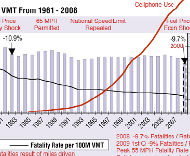Article from: www.thenewspaper.com/news/41/4181.asp
8/16/2013
Study Rejects Cell Phone Driving Danger Claims
Study documents the first safety evaluation of moving vehicles that used cell phones.
 A study published in the August edition American Economic Journal rejects the commonly held view that the proliferation of cell phone use among the driving public has made travel more dangerous. Politicians have seized on the perception and outlawed driving while talking on a handheld cell phone in eleven states. Many other states are considering following suit.
A study published in the August edition American Economic Journal rejects the commonly held view that the proliferation of cell phone use among the driving public has made travel more dangerous. Politicians have seized on the perception and outlawed driving while talking on a handheld cell phone in eleven states. Many other states are considering following suit.
Saurabh Bhargava from with Carnegie Mellon University and Vikram S. Pathania from the London School of Economics found no correlation between the rise in cell phone use and any increase in traffic collisions, the findings of 125 published studies to the contrary.
The researchers began by posing a difficult question for the politicians and rival study authors: Why has cell phone use skyrocketed at the same time that traffic accidents and fatalities are at an all-time low? In a 2009 report, the Best Highway Practices Institute showed the disconnect between the rates of mobile phone usage and fatalities (view chart). The new study replicates the findings, and goes the next step with a more direct analysis.
"No study has yet provided causal evidence of the relationship between cell phone use and crashes in the field," the researcers explained. "In this paper, we adopt a unique approach, and novel data, to estimate the causal link between cellular use and the crash rate."
The researchers obtained data from an eleven-day period in 2005 where the call was placed among multiple cell towers, indicating the cell phone was in a moving vehicle. The data show a 7.2 percent increase in call frequency after 9pm or on weekdays when the cell provider's calling plans offered a steep "off peak" discount.
The researchers next checked whether the increased usage triggered an increase in the number of accidents.
"The 9pm pricing analysis provides no evidence for a relative increase in crashes at the threshold," the researchers found. "The point estimates for the change in relative crash rates across the threshold are consistently near zero."
The study does assume that most of the moving cell phone use is from drivers, not passengers. The study takes advantage of survey data regarding the frequency of driving with a mobile phone to show the study's results are consistent.
The study found that fatal accident rates did not see either a short-term or a long-term drop in the states that adopted cell phone driving bans. Among possible explanations, the study suggested drivers who use cell phones compensate for the potential distraction by paying more attention to the road and alleviating boredom or sleepiness. Certain types of drivers, old or young, may have higher crash risk and others lower when using a phone, yielding no change overall.
Source: Driving under the (Cellular) Influence (American Economic Journal, 8/1/2013)
Permanent Link for this item
Return to Front Page
 A study published in the August edition American Economic Journal rejects the commonly held view that the proliferation of cell phone use among the driving public has made travel more dangerous. Politicians have seized on the perception and outlawed driving while talking on a handheld cell phone in eleven states. Many other states are considering following suit.
A study published in the August edition American Economic Journal rejects the commonly held view that the proliferation of cell phone use among the driving public has made travel more dangerous. Politicians have seized on the perception and outlawed driving while talking on a handheld cell phone in eleven states. Many other states are considering following suit.